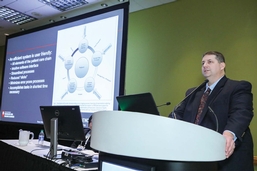Improving radiology efficiency in the emergency department (ED) need not come at the expense of quality. That was the message from keynote speaker Scott Steenburg, MD, and other presenters during a session on emergency radiology and practice management on Sunday.

Steenburg
"There are many things each of us as leaders can do to set radiologists up for success," said Dr. Steenburg, an emergency and trauma radiologist at Indiana University School of Medicine and Indiana University Health. "But you have to design the whole process with both efficiency and quality in mind."
When it comes to efficiency, Dr. Steenburg said one component is understanding workflow and workload, and how to optimize both in parallel with one another. He said leaders should use data to understand historically how busy their ED is at particular times of day and to learn about the capacity of their staff. These data points can ensure that a department isn't understaffed during its busiest hours or overstaffed during a slow time.
"You want to create a schedule that will not burn radiologists out," Dr. Steenburg said, "but will still maintain steady turnaround times and not allow the work to get out of hand."
One example of creative staffing is to use a reading room assistant or consultation radiologist to answer calls and deal with the everyday distractions and interruptions that happen in the ED, giving radiologists more time to read scans and move through cases efficiently, he said.
Analyzing 24/7 Staffing in the ED
One study presented in the session analyzed the effect of implementing 24/7 staffing at a Level I trauma center in Canada. Francesco Macri, MD, PhD, of the Department of Emergency and Trauma Radiology at Vancouver General Hospital, and colleagues conducted a retrospective chart analysis on all patients over 18 years old with scans performed in the emergency department a year before the 24/7 staffing was implemented, and a year after.
The Canadian Triage and Acuity Score (CTAS) was recorded for each patient, with categories ranging from most to least acute: Resuscitation, emergent, urgent, less urgent and non-urgent. Researchers calculated the time between imaging request and end of imaging and between end of imaging and the final report.
The study found that for urgent patients, the time between image request and end of the imaging exam dropped by 87 minutes once 24/7 staffing was implemented. The time between end of imaging and final report dropped in all categories by at least four hours.
"Our results demonstrate the importance of having a radiologist available in the emergency department at all times," Dr. Macri said. "High-quality of care shouldn't just be from 8 a.m. to 5 p.m. — it should be 24/7, especially in the emergency department."
Defining, Measuring Goals is Critical
On the quality side, Dr. Steenburg said every department needs to talk about their goals and define what quality means to them, and then set up studies and projects to measure those goals. Quality metrics need to be clearly defined, meaningful and measurable, he said.
"If we aren't tracking what we do and how well we do it, we don't know what needs to be fixed," Dr. Steenburg said. "Be your own case study."
Although quality improvement programs may look different at different institutions, they have a similar goal.
"The number one priority is superior patient care," Dr. Steenburg said. "If you set up systems and practices that allow you, as a radiologist, to do your best job, that will downstream and have a positive influence on patient care."
Related links:
Twitter Poll
Would 24-hour staff radiologist coverage in an Emergency Department reduce times for imaging and report finalization?
— RSNA (@RSNA) December 1, 2019
A video interview with Dr. Steenburg.

